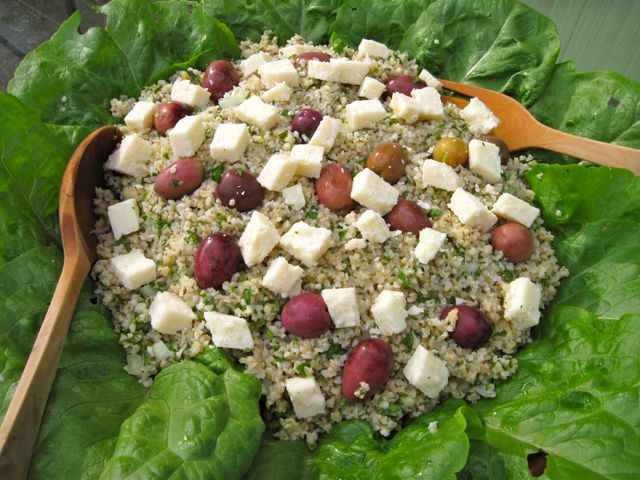
reference-image, l
(post, Linda Ziedrich)
During a long, cool spring — like the one we experienced in the Pacific Northwest last year and the one we’re grousing about now — the rare warm day is an occasion for celebration. In summer, I often try to satisfy my craving for tabbouleh, the Middle Eastern salad of parsley, mint, and bulgur wheat, only to find my parsley gone to seed and my mint old and tough. Spring, not summer, is the best season here for tabbouleh. But as a main course, at least, tabbouleh is best on a warm day. So one day recently, when the thermometer neared 70 degrees, I set out to make tabbouleh for lunch, with tender parsley, mint, and lettuce from rain-soaked garden beds. Tabbouleh (tabouleh, tabouli, tabooley — spell it as you will) is often served with little cupped leaves of romaine lettuce, which serve as scoops for the mixture of wheat and herbs. Although I had no romaine, my butter lettuce was at its best, so I picked some as a bed for the salad. And along with spearmint, I picked some lemon balm, a citrus-scented member of the mint family that has become a weed in my garden. [%image reference-image float=left width=400 caption="Greens for salad."] Traditionally, tabbouleh is made with fine bulgur (or burghul), which you can find in Lebanese and Turkish markets. Bulgur is wheat that has been parboiled, parched dry, coarsely ground, and then rubbed to remove the outer layers. Covered in water, it quickly swells to a texture perfect for eating. Medium or coarse bulgur, available in many supermarkets, will do well enough for tabbouleh, but it will need longer soaking, and you may want to use hot water rather than cold. (Bulgur is not the same as cracked wheat. If you want to substitute ordinary cracked wheat for bulgur, you’ll have to cook the wheat and then let it cool.) In summer, tabbouleh is often served with sliced or cubed cucumber, pepper, or tomato, and with grape leaves rather than lettuce. I decorated my tabbouleh this time with home-cured olives and cubes of cotija cheese; feta would have been just as good. My husband’s homemade pinot gris wine made a fine accompaniment. I never measure ingredients when I make tabbouleh, but here’s an approximate recipe: [%image tabbouleh float=right width=400 caption="Tabbouleh"]Tabbouleh 2 cups bulgur 1 cup minced onion Salt to taste 1 1/2 cups minced parsley 1/2 cup minced spearmint, or a mixture of spearmint and lemon balm 1/2 cup lemon juice, or more 1/2 cup olive oil, or more Fresh lettuce or brined grape leaves Olives Cubed or crumbled feta or cotija cheese Put the bulgur into a bowl, cover it with water, and let the bulgur soak for an hour. Drain and press out any excess water. Mix the bulgur with the onions, crushing the onions with your fingers. Add salt to taste. Stir in the herbs, the half-cup lemon juice, and the half-cup olive oil. Taste the salad, and add more salt, lemon juice, or oil, if you like. Serve the tabbouleh immediately, with lettuce or grape leaves if you like, or chill the salad until you’re ready to eat. Garnish with olives and feta or cotija cheese if you wish. p(blue). Culinate editor's note: This post also appeared on Linda Ziedrich's blog, A Gardener's Table.

reference-image, l

tabbouleh, l